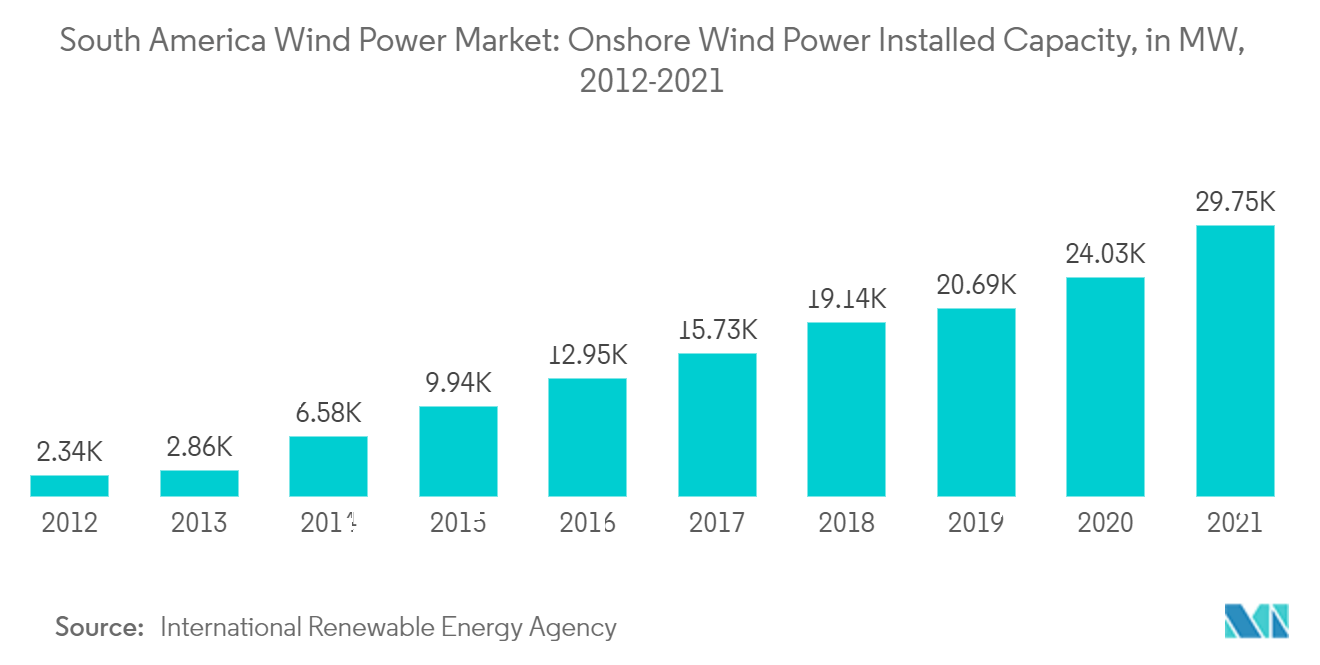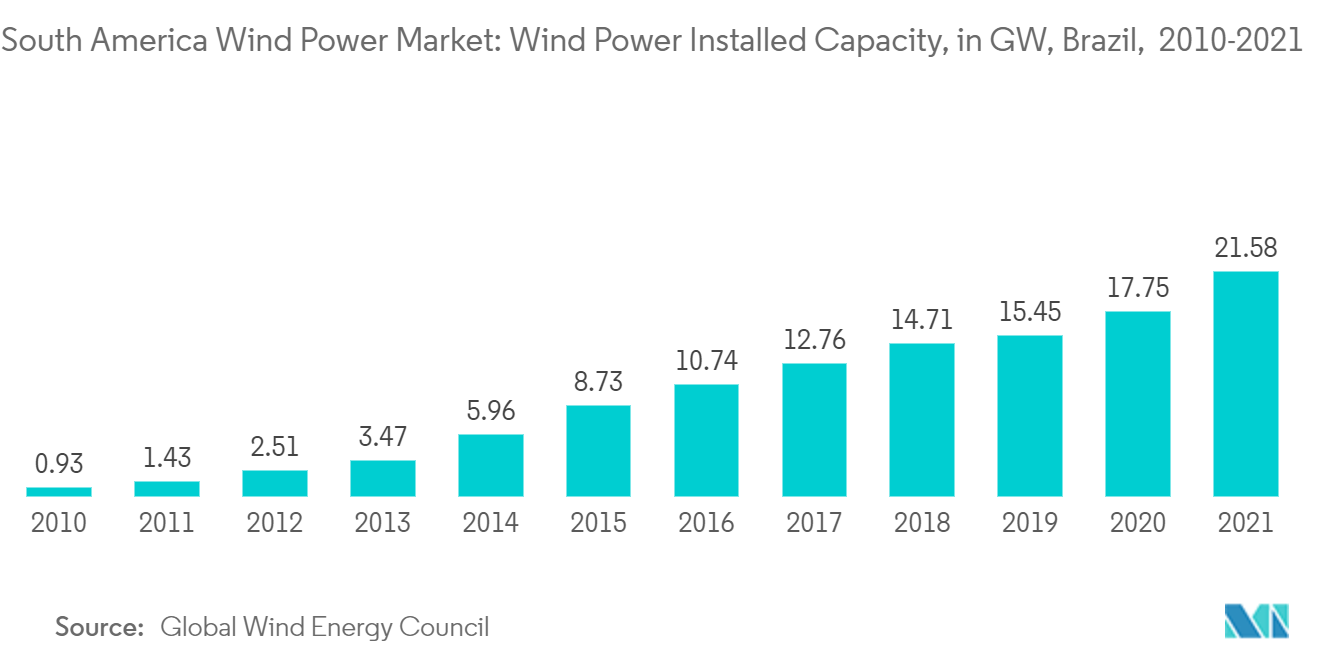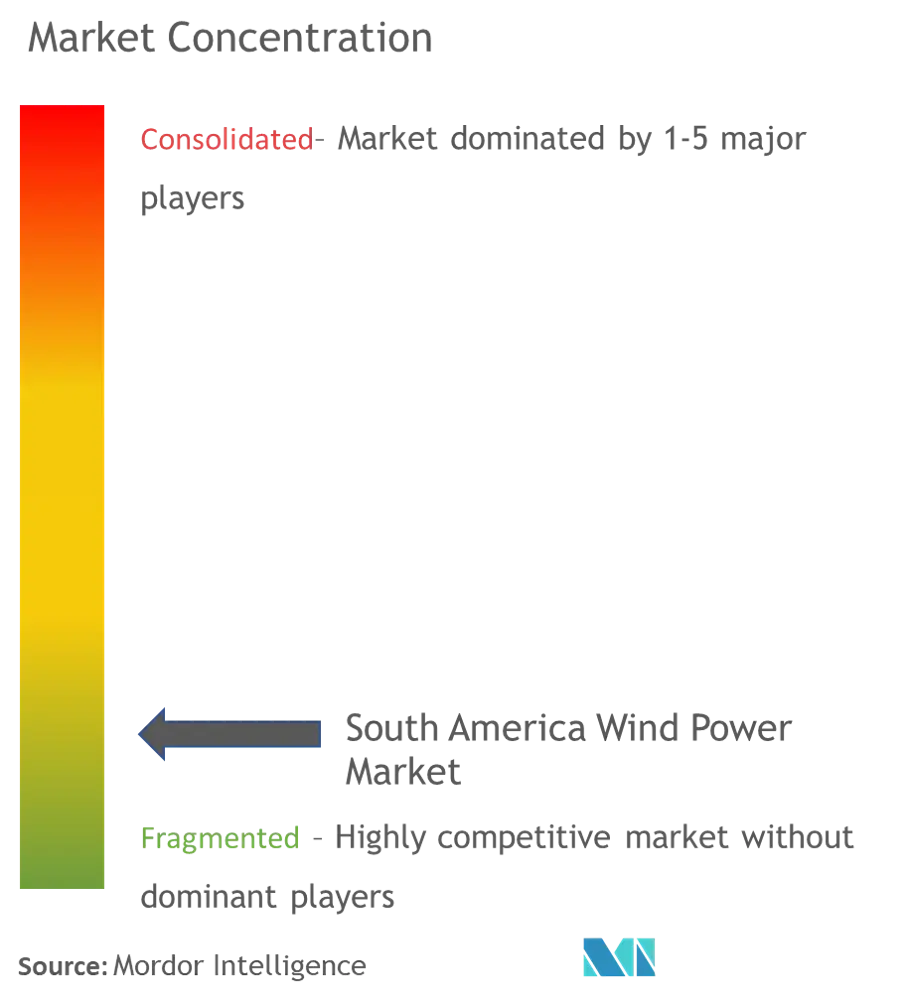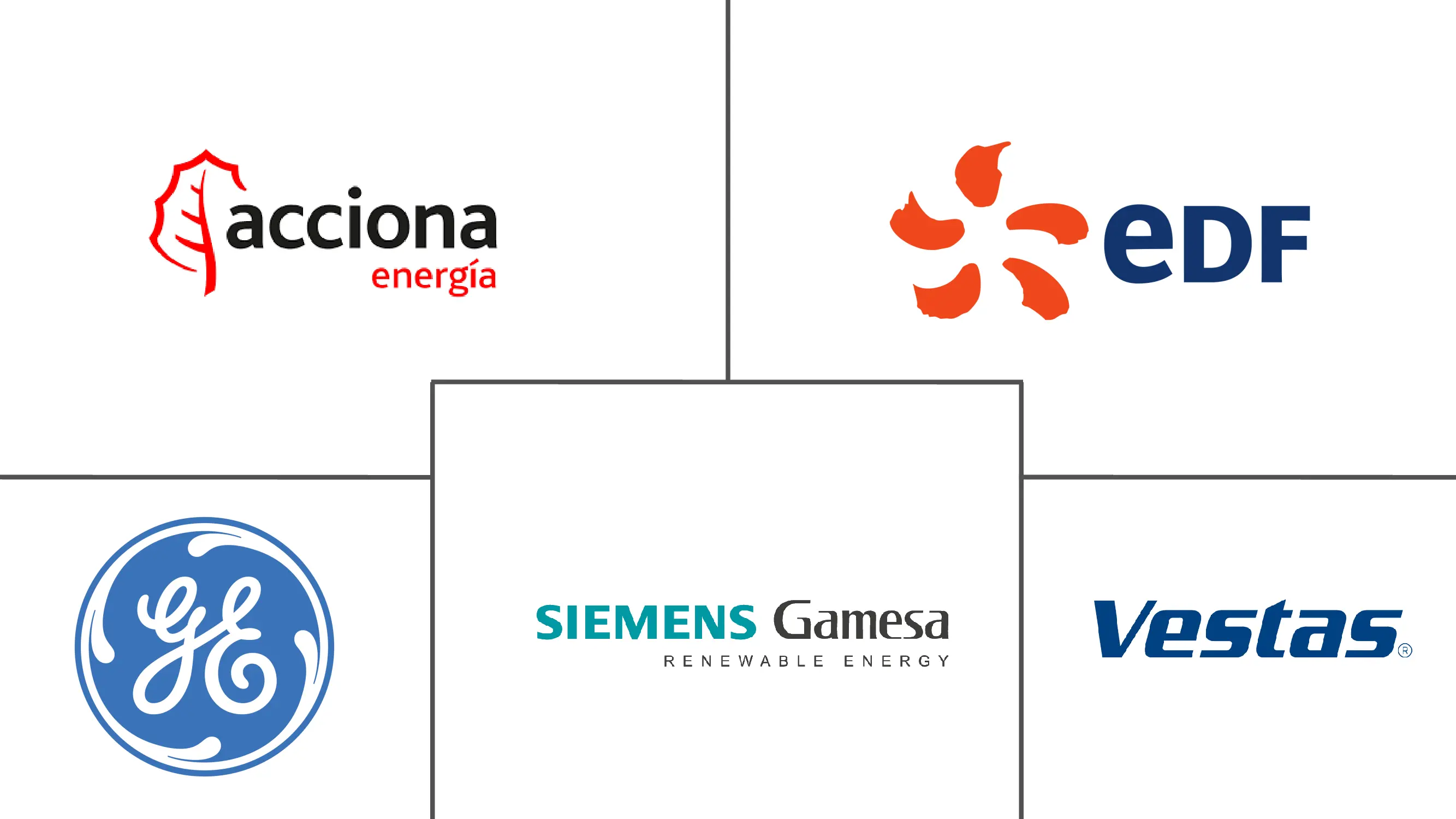
South America Wind Power Market Analysis by Mordor Intelligence
The South America Wind Power Market is expected to register a CAGR of less than 7.9% during the forecast period.
COVID-19 moderately impacted the market in 2020. Currently, the market is likely to reach pre-pandemic levels.
- Over the medium term, major factors attributing to the growth include favorable government policies, the increasing investment in wind power projects, and the reduced cost of wind energy, which led to increased adoption of wind energy, thereby positively contributing to the demand for wind energy.
- On the other hand, the increasing adoption of alternate energy sources, such as gas-based power and solar power, is likely to hinder the market growth.
- Nevertheless, the technological advancements in efficiency and decrease in the production cost of offshore wind turbines are expected to create ample opportunity for the market players in South America.
- In South America, Brazil had the highest installed capacity in 2021 and is expected to be the largest market during the forecast period, bolstered by constant growth in onshore wind power additions and upcoming offshore wind power projects.
South America Wind Power Market Trends and Insights
Onshore Segment to Dominate the Market
- Onshore wind energy power generation technology has evolved over the last five years to maximize electricity produced per megawatt capacity installed and to cover more sites with lower wind speeds. Besides this, in recent years, wind turbines have become more extensive with taller hub heights, broader diameters, and larger wind turbine blades.
- As of 2021, South America wind power consists of 100% onshore wind installations. The region had 29,754 MW of cumulative wind energy installations.
- The new Energy Transition Law of Colombia, enacted in July 2021, represents the government's commitment to achieving its climate change objectives and becoming a net-zero energy country. On the other hand, the Colombian government had approved the Generation Transmission Reference Expansion Plan for 2016-2030. In terms of generation, the plan stipulates that Colombia needs an additional 5,362 MW over the period above. It is planned to be distributed as follows - wind (1,456 MW), hydro (1,427 MW), coal (970), and smaller plants (793 MW).
- Chile is one of the first South American nations to declare a complete coal phase-out, announcing a plan to retire 1 GW of coal power by 2024. The country made regional low-carbon commitments with the Renewable Energy for Latin America and the Caribbean initiative, pledging a collective target of 70% renewable energy use by 2030.
- Chilean government's objective is that by 2050, about 70% of the energy consumed in the country will be from sources such as solar thermal, photovoltaic, or wind energy, adding to the announcement of the decarbonization plan. This is part of the country's ambitious decarbonization plan of completely phasing out coal plants by 2040 and achieving carbon neutrality by 2050.
- Additionally, in April 2021, Statkraft announced that the company plans to build its first wind farms in Chile with an installed capacity of more than 366 MW by the end of 2023. The wind power plants are expected to produce more than 300 GW of electricity annually, enough power to supply 10 million average Chilean households. The project is located in the O'Higgins region, 124 kilometers south of Santiago.
- Furthermore, decreasing the cost of power generation and growing investments, particularly in Brazil, Chile, Colombia, and Argentina, are expected to drive the onshore wind turbine installation, which, in turn, is expected to drive the wind power market in the region during the forecast period.

Brazil to Dominate the Market
- Wind power in Brazil has proved to be the most competitive technology, with an average price of BRL 98.62/MWh (around USD 30/MWh), well below the prices of large hydropower plants.
- The Association (Abeeólica) also stated that the country is expected to have nearly 18.8 GW of installed wind capacity by 2024, considering 186 new wind farms that are scheduled to come online by 2024. In addition to this, the government's 10-year energy development plan forecasts the country to reach 28.5 GW of wind capacity by 2026.
- Brazil has the highest capacity of wind energy installations in the region as of December 2021. The country had 21,580 MW of cumulative wind energy installations, out of which 3,830 MW of wind energy were installed in 2021.
- In January 2022, Statkraft announced that the company is ready to start construction of its Morro do Cruzeiro large-scale wind energy project in north-eastern Brazil after closing a turbine supply contract with German wind turbine manufacturer Nordex. The project entails two wind farms, 14 turbines, and a total installed capacity of 80 MW.
- Decree No. 10.946/2022 was issued by the Brazilian government on 25 January 2022, which specifies key provisions for allocating natural resources and physical space in open waters for energy production. The decree came into effect on 15thJune 2022. Under the decree, a framework for the assessment of the seabed is provided for the development of offshore wind projects, as well as the stages of planning and permitting are being defined to ensure that the implementation of this technology is facilitated in a timely fashion.
- A growing number of investors are focusing on Brazil, as indicated by the licensing requests submitted to the Brazilian Institute of the Environment and Renewable Natural Resources (IBAMA) for more than 80 GW of offshore wind projects. According to Brazil's Energy Research Office (EPE's) roadmap, Brazilian technical resource potential is approximately 700 GW. Further, EPE estimates that by 2050, Brazil will have 16 GW of installed offshore wind capacity, with a 20% reduction in CAPEX.
- As a result, the Brazilian wind power market is expected to witness robust growth during the forecast period, in the wake of the declining cost of wind energy and supportive government policies.

Competitive Landscape
South America Wind Power Market could be more cohesive. Some key players in the biogas market (not in particular order) include Acciona Energia SA, Vestas Wind Systems AS, Siemens Gamesa Renewable Energy SA, Xinjiang Goldwind Science & Technology Co. Ltd (Goldwind), EDF SA, and General Electric, among others.
South America Wind Power Industry Leaders
-
Acciona Energia SA
-
EDF SA
-
General Electric Company
-
Siemens Gamesa Renewable Energy
-
Vestas Wind Systems AS
- *Disclaimer: Major Players sorted in no particular order

Recent Industry Developments
- February 2022: Tenaris planned to invest USD 190 million in constructing a new Argentine wind farm, expected to come online by mid-2023, with a capacity of 101 MW. The project is located in Adolfo Gonzales Chaves, Buenos Aires province, and is expected to generate approximately 509 GWh a year.
- November 2021: Acciona Energía, a Spanish renewable energy company, signed an agreement with Casa dos Ventos, a Brazilian investment group, to acquire two wind projects in the country. The Sento Se wind farms are developing, and their acquisition is likely to mark Acciona Energía's entry into the Brazilian renewable energy market.
South America Wind Power Market Report Scope
The wind produces electricity by converting the kinetic energy of air in motion into electricity. By rotating the rotor blades, wind transforms kinetic energy into rotational energy. The rotational energy is transferred to the generator through a shaft, generating electrical power.
South America wind power market is segmented by location of deployment. By location of deployment, the market is segmented into onshore and offshore. The report also covers the market size and forecasts for the wind power market across the countries in the region. For each segment, the market sizing and forecasts have been done based on installed capacity (GW).
| Onshore |
| Offshore |
| Brazil |
| Chile |
| Argentina |
| Rest of South America |
| Location | Onshore |
| Offshore | |
| Geography | Brazil |
| Chile | |
| Argentina | |
| Rest of South America |
Key Questions Answered in the Report
What is the current South America Wind Power Market size?
The South America Wind Power Market is projected to register a CAGR of less than 7.9% during the forecast period (2025-2030)
Who are the key players in South America Wind Power Market?
Acciona Energia SA, EDF SA, General Electric Company, Siemens Gamesa Renewable Energy and Vestas Wind Systems AS are the major companies operating in the South America Wind Power Market.
What years does this South America Wind Power Market cover?
The report covers the South America Wind Power Market historical market size for years: 2021, 2022, 2023 and 2024. The report also forecasts the South America Wind Power Market size for years: 2025, 2026, 2027, 2028, 2029 and 2030.
Page last updated on:
South America Wind Power Market Report
Statistics for the 2025 South America Wind Power market share, size and revenue growth rate, created by Mordor Intelligence™ Industry Reports. South America Wind Power analysis includes a market forecast outlook for 2025 to 2030 and historical overview. Get a sample of this industry analysis as a free report PDF download.



